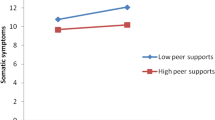Abstract
The present study investigated children's responses to a peer's childhood depression. Younger children in third and fourth grade and older children in fifth and sixth grade were exposed to one of four films. The four films portrayed a female peer who was either depressed or not depressed and who had experienced numerous recent life stresses or no recent life stress. Overall, children rated the depressed peers as less likable and attractive, as engaging in fewer positive current and future behaviors, and as needing therapy more than a nondepressed peer. There was a tendency to rate the depressed peer with high life stress more positively than the depressed peer with low life stress; this tendency decreased with age. Girls rated all of the peers and especially the stressed peers more positively than did the boys. The results are discussed in terms of the implications of children's social interaction for the initiation or maintenance of childhood depression.
Similar content being viewed by others
References
American Psychiatric Association. (1980).Diagnostic and statistical manual of mental disorders-DSM III: (3rd ed.). Washington, D.C.: Author.
Bock, R. D., & Haggard, E. A. (1968). The use of a multivariate analysis of variance in behavioral research. In D. K. Witla (Ed.),Handbook of measurement and assessment in behavioral sciences (pp. 100–142). Reading, Massachusetts: Addison-Wesley.
Boswell, P. C., & Murray, E. J. (1981). Depression, schizophrenia, and social attraction.Journal of Consulting and Clinical Psychology, 49, 641–647.
Costello, C. E. (1981). Childhood depression. In E. J. Mash & L. G. Terdal (Eds.),Behavioral assessment of childhood disorders (pp. 305–344). New York: Guilford.
Coyne, J. C. (1976a). Toward an interactional description of depression.Psychiatry, 39, 28–40.
Coyne, J. C. (1976b). Depression and the response of others.Journal of Abnormal Psychology, 85, 186–193.
Hammen, C. L., & Peters, S. D. (1977). Differential responses to male and female depressive reactions.Journal of Consulting and Clinical Psychology, 45, 994–1001.
Hammen, C. L., & Peters, S. D. (1978). Interpersonal consequences of depression: Responses to men and women enacting a depressed role.Journal of Abnormal Psychology, 87, 322–332.
Hoehn-Hyde, D., Schlottman, R. S., & Rush, A. J. (1982). Perception of social interactions in depressed psychiatric patients.Journal of Consulting and Clinical Psychology, 50, 209–212.
Howes, M. J., & Hokanson, J. E. (1979). Conversational and social responses to depressive interpersonal behavior.Journal of Abnormal Psychology, 88, 625–634.
Jones, C., & Aronson, E. (1973). Attribution of fault to a rape victim as a function of respectability of the victim.Journal of Personality and Social Psychology, 26, 415–419.
Kovacs, M. (1981). Rating scales to assess depression in school-aged children.Acta Paedopsychiatrica, 46, 305–315.
Lefkowitz, M. M., & Tesiny, E. P. (1980). Assessment of childhood depression.Journal of Consulting and Clinical Psychology, 48, 43–50.
Leon, G. R., Kendall, P. C., & Garber, J. (1980). Depression in children: Parent, child, and teacher perspectives.Journal of Abnormal Child Psychology, 8, 221–235.
Lerner, M. J. (1975). The justice motive in social behavior.Journal of Social Issues, 31, 1–20.
Maas, E., Maracek, J., & Travers, J. R. (1978). Children's conception of disordered behavior.Child Development, 49, 146–154.
Mullins, L. L., & Siegel, L. J. (1981).Childhood depression, interpersonal cognitive problemsolving, and life stress. Paper presented at the meeting of the Association for the Advancement of Behavior Therapy, Toronto, Canada.
Novak, D. W. (1974). Children's reactions to emotional disturbance in imaginary peers.Journal of Consulting and Clinical Psychology, 42, 462.
Pearce, J. B. (1977). Depressive disorder in childhood.Journal of Child Psychology and Psychiatry, 18, 79–82.
Raskin, A. (1977). Depression in children: Fact or fallacy? In J. G. Schulterbrandt & A. Raskin (Eds.),Depression in childhood: Diagnosis, treatment, and conceptual models (pp. 141–146). New York: Raven Press.
Rubin, H., & Ross, H. S. (Eds.) (1982).Peer relationships and social skills in childhood. New York: Springer-Verlag.
Schwartz, M., Friedman, R., Lindsay, P., & Narrol, H. (1982). The relationship between conceptual tempo and depression in children.Journal of Consulting and Clinical Psychology, 50, 488–490.
Winer, D. L., Bonner, T. O., Blaney, P. N., & Murray, E. J. (1981). Depression and social attraction.Motivation and Emotion, 5, 153–165.
Author information
Authors and Affiliations
Additional information
The authors would like to thank Kelly Merk and Susan Vanderheid for their assistance with this research.
Rights and permissions
About this article
Cite this article
Peterson, L., Mullins, L.L. & Ridley-Johnson, R. Childhood depression: Peer reactions to depression and life stress. J Abnorm Child Psychol 13, 597–609 (1985). https://doi.org/10.1007/BF00923144
Revised:
Issue Date:
DOI: https://doi.org/10.1007/BF00923144




